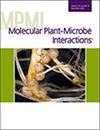求助PDF
{"title":"土传真菌长孢黄萎病及其与十字花科寄主的相互作用。","authors":"Vahideh Rafiei, Christina Dixelius, Georgios Tzelepis","doi":"10.1094/MPMI-03-25-0029-IRW","DOIUrl":null,"url":null,"abstract":"<p><p><i>Verticillium longisporum</i>, a soilborne fungal species, is the causative agent of Verticillium stripe disease in <i>Brassica</i> species and represents a notable threat to agricultural production, particularly in regions where oilseed rape is a major crop, including Europe, North America, and Asia. The microsclerotia of this pathogen can persist in the soil for extended periods, with a potential lifespan of up to a decade, thereby posing a substantial challenge for the complete eradication of the pathogen from infested soil. The genome of <i>V. longisporum</i> is amphidiploid and resulted from the hybridization of <i>V. dahliae</i> (D genotypes) and an unidentified species (A1 genotype). At least three independent hybridization events are estimated to have occurred, resulting in three distinct lineages: A1/D1, A1/D2, and A1/D3. Genome sequence analysis revealed the presence of mating-type idiomorphs, putative cell wall-degrading enzymes, and effectors. However, due to the complexity of the genome, there is a paucity of research on the molecular interactions between <i>V. longisporum</i> and <i>Brassica</i> crops. This review summarizes the extant knowledge regarding the pathogenicity factors that <i>V. longisporum</i> deploys upon infection and the host immune responses against this attack, highlighting aspects that remain to be elucidated and the molecular tools available for studying this interaction. A better understanding of the molecular interactions in this pathosystem will contribute to developing more effective control measures against this disease in <i>Brassica</i> oilseed and cabbage crops. [Formula: see text] Copyright © 2025 The Author(s). This is an open access article distributed under the CC BY-NC-ND 4.0 International license.</p>","PeriodicalId":19009,"journal":{"name":"Molecular Plant-microbe Interactions","volume":" ","pages":"497-504"},"PeriodicalIF":3.4000,"publicationDate":"2025-07-01","publicationTypes":"Journal Article","fieldsOfStudy":null,"isOpenAccess":false,"openAccessPdf":"","citationCount":"0","resultStr":"{\"title\":\"The Soilborne Fungus <i>Verticillium longisporum</i> and Its Interactions with the Brassicaceous Hosts.\",\"authors\":\"Vahideh Rafiei, Christina Dixelius, Georgios Tzelepis\",\"doi\":\"10.1094/MPMI-03-25-0029-IRW\",\"DOIUrl\":null,\"url\":null,\"abstract\":\"<p><p><i>Verticillium longisporum</i>, a soilborne fungal species, is the causative agent of Verticillium stripe disease in <i>Brassica</i> species and represents a notable threat to agricultural production, particularly in regions where oilseed rape is a major crop, including Europe, North America, and Asia. The microsclerotia of this pathogen can persist in the soil for extended periods, with a potential lifespan of up to a decade, thereby posing a substantial challenge for the complete eradication of the pathogen from infested soil. The genome of <i>V. longisporum</i> is amphidiploid and resulted from the hybridization of <i>V. dahliae</i> (D genotypes) and an unidentified species (A1 genotype). At least three independent hybridization events are estimated to have occurred, resulting in three distinct lineages: A1/D1, A1/D2, and A1/D3. Genome sequence analysis revealed the presence of mating-type idiomorphs, putative cell wall-degrading enzymes, and effectors. However, due to the complexity of the genome, there is a paucity of research on the molecular interactions between <i>V. longisporum</i> and <i>Brassica</i> crops. This review summarizes the extant knowledge regarding the pathogenicity factors that <i>V. longisporum</i> deploys upon infection and the host immune responses against this attack, highlighting aspects that remain to be elucidated and the molecular tools available for studying this interaction. A better understanding of the molecular interactions in this pathosystem will contribute to developing more effective control measures against this disease in <i>Brassica</i> oilseed and cabbage crops. [Formula: see text] Copyright © 2025 The Author(s). This is an open access article distributed under the CC BY-NC-ND 4.0 International license.</p>\",\"PeriodicalId\":19009,\"journal\":{\"name\":\"Molecular Plant-microbe Interactions\",\"volume\":\" \",\"pages\":\"497-504\"},\"PeriodicalIF\":3.4000,\"publicationDate\":\"2025-07-01\",\"publicationTypes\":\"Journal Article\",\"fieldsOfStudy\":null,\"isOpenAccess\":false,\"openAccessPdf\":\"\",\"citationCount\":\"0\",\"resultStr\":null,\"platform\":\"Semanticscholar\",\"paperid\":null,\"PeriodicalName\":\"Molecular Plant-microbe Interactions\",\"FirstCategoryId\":\"99\",\"ListUrlMain\":\"https://doi.org/10.1094/MPMI-03-25-0029-IRW\",\"RegionNum\":3,\"RegionCategory\":\"生物学\",\"ArticlePicture\":[],\"TitleCN\":null,\"AbstractTextCN\":null,\"PMCID\":null,\"EPubDate\":\"2025/7/24 0:00:00\",\"PubModel\":\"Epub\",\"JCR\":\"Q2\",\"JCRName\":\"BIOCHEMISTRY & MOLECULAR BIOLOGY\",\"Score\":null,\"Total\":0}","platform":"Semanticscholar","paperid":null,"PeriodicalName":"Molecular Plant-microbe Interactions","FirstCategoryId":"99","ListUrlMain":"https://doi.org/10.1094/MPMI-03-25-0029-IRW","RegionNum":3,"RegionCategory":"生物学","ArticlePicture":[],"TitleCN":null,"AbstractTextCN":null,"PMCID":null,"EPubDate":"2025/7/24 0:00:00","PubModel":"Epub","JCR":"Q2","JCRName":"BIOCHEMISTRY & MOLECULAR BIOLOGY","Score":null,"Total":0}
引用次数: 0
引用
批量引用

 求助内容:
求助内容: 应助结果提醒方式:
应助结果提醒方式:


